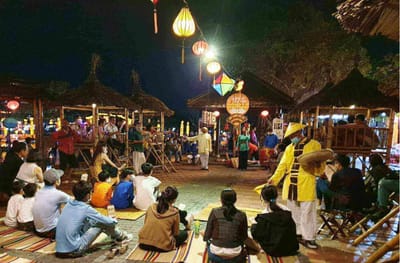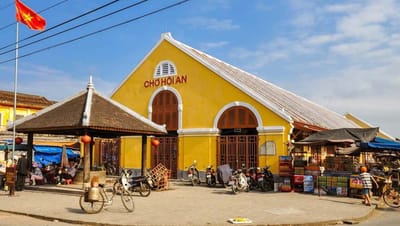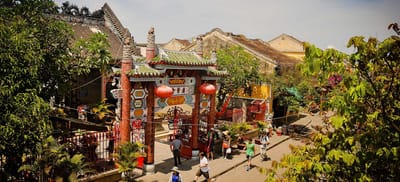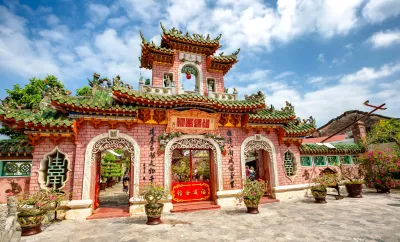Hoi An Old Town Walking Routes - Self-Guided Tour Maps

Hoi An Ancient Town's pedestrian-friendly streets and compact layout make self-guided walking the ideal exploration method. Unlike attraction guides that detail what to see, these routes provide precise how to navigate the UNESCO heritage core, with turn-by-turn directions, strategic timing, and downloadable maps for offline use.
Understanding Hoi An's Walking Environment
Pedestrian-Only Hours
Hoi An restricts motorized vehicles during designated walking hours to preserve the ancient town's atmosphere and visitor safety. The current schedule operates year-round with seasonal variations:
Morning Session: 9:00 AM – 11:00 AM (pedestrian and bicycle only)
Afternoon/Evening Session: 3:00 PM – 9:00 PM (winter) or 3:00 PM – 9:30 PM (summer)
Key point: Visit during 7:00-9:00 AM for the quietest experience before pedestrian-only hours begin. You'll encounter local life—market vendors, street sweepers, and residents starting their day—with minimal tourist crowds and exceptional morning light for photography
Bicycles remain permitted during walking hours, though the narrow lanes and crowds make foot travel more practical for stopping at heritage sites.
Navigation Essentials
The ancient town follows a grid pattern parallel to the Thu Bon River. Tran Phu Street serves as the main east-west artery, with perpendicular streets extending north from the riverfront. Most heritage sites cluster within a 30-hectare core zone walkable in 15-20 minutes end-to-end.
Starting Points: Most routes begin near the intersection of Tran Phu and Hoang Dieu streets, where ticket booths and information centers provide free paper maps. The distinctive red Japanese ship replica at 79 Nguyen Thi Minh Khai serves as an alternative meeting point.
Route 1: Essential Old Town Loop
Duration: 2-3 hours
Distance: 2 kilometers
Best Time: 7:00-10:00 AM or 4:00-7:00 PM
Difficulty: Easy, flat terrain
Ticket Requirements: 2-3 heritage coupons recommended
This route covers Hoi An's most significant heritage sites in a logical circuit, ideal for first-time visitors or those with limited time.
Step-by-Step Directions
Stop 1: Ticket Booth & Orientation (Hoang Dieu & Tran Phu intersection)
Purchase your heritage ticket at the yellow booth. Request a free paper map. Face east on Tran Phu Street with the river on your right.
Stop 2: Fabric Market (100 meters east on Tran Phu)
Pass through the covered textile market on your left. No ticket required; browse custom tailoring shops and observe merchants preparing fabric displays.
Stop 3: Fujian Assembly Hall (200 meters, left side of Tran Phu)
The most ornate assembly hall, identifiable by elaborate rooflines and guardian lion statues. Use one ticket coupon. Allow 20-30 minutes to explore courtyards, the temple to Thien Hau (sea goddess), and architectural details. [Link to: Hoi An Ancient Town: Complete UNESCO Heritage Guide for assembly hall context]
Stop 4: Japanese Covered Bridge (400 meters, Tran Phu terminus)
Continue east to Hoi An's most iconic landmark. Cross the 18-meter bridge connecting Tran Phu and Nguyen Thi Minh Khai streets. Free to cross during early morning; ticket required 9:00 AM onwards. Photograph from the west side for morning light on the yellow facade. [Link to: Japanese Covered Bridge: History & Visiting Tips for architectural details]
Stop 5: Cantonese Assembly Hall (Turn right on Nguyen Thi Minh Khai, 150 meters)
Dedicated to General Guan Yu, featuring intricate wood carvings and stone sculptures. Use one ticket coupon. Less crowded than Fujian Hall; allow 15-20 minutes.
Stop 6: Red Japanese Ship Replica (Continue 100 meters on Nguyen Thi Minh Khai)
Life-size model of 16th-century trading vessels. Free photo opportunity; no interior access.
Stop 7: Turn left onto Cong Nu Ngoc Hoa Street (Narrow pedestrian lane)
This atmospheric alley showcases residential tube houses with lantern-maker shops. No tickets required; excellent for observing daily life and photographing yellow walls.
Stop 8: Cross wooden footbridge to Nguyen Thai Hoc Street
Turn right (west) toward Central Market. This section features silk merchants, handicraft workshops, and cafes.
Stop 9: Tan Ky Ancient House (On Nguyen Thai Hoc, watch for brown signage)
The most visited ancient house, preserved for seven generations. Use one ticket coupon. Study the triple-beam Japanese ceiling structure and Chinese decorative elements. Allow 20-30 minutes. [Link to: Tan Ky Ancient House: 280-Year-Old Family Home for complete history]
Stop 10: Central Market (Nguyen Thai Hoc & Tran Phu corner)
End at the bustling two-story market. Ground floor: fresh produce, herbs, local vendors. Upper floor: souvenirs, textiles. No ticket required. Recommended breakfast stop for cao lau noodles or Vietnamese coffee.
Rest & Refreshment Points
- Coffee: Faifo Coffee (rooftop views, see Photography Route)
- Breakfast/Lunch: Central Market food stalls, Banh Mi Phuong (13 Phan Chu Trinh)
- Restrooms: Central Market upper floor, heritage site facilities
Photo Opportunities: Japanese Bridge (west side, morning), yellow walls on Cong Nu Ngoc Hoa, river views from Nguyen Thai Hoc.
Route 2: Photography Golden Route
Duration: 1.5 hours
Focus: Best light and compositions
Best Time: 5:30-7:00 AM (sunrise) OR 4:30-6:00 PM (golden hour)
Ticket Requirements: Optional (1 coupon if entering sites)
This route prioritizes photographic locations over heritage site interiors, targeting optimal natural light for iconic Hoi An imagery.
Sunrise Route (5:30-7:00 AM)
Stop 1: Thu Bon Riverfront (Bach Dang Street, near An Hoi Bridge)
Begin at the eastern riverfront for sunrise reflections on the water. Fishing boats and sampans create foreground interest. The ancient town skyline glows as sunlight hits yellow facades.
Stop 2: Central Market (6:00 AM)
Capture vendors arranging produce, morning rituals, and authentic local life before tourist crowds. Vibrant colors under soft light; respect personal space and ask permission for portraits.
Stop 3: Tran Phu Street (6:15 AM)
Walk west on Tran Phu as low-angle sunlight illuminates building facades. Empty streets allow unobstructed architectural shots. Focus on symmetry, leading lines, and the contrast between yellow walls and green shutters.
Stop 4: Japanese Bridge - East Side (6:30 AM)
Position yourself on Nguyen Thi Minh Khai facing west. Backlit morning sun creates silhouettes and dramatic contrast. Wait for cyclists or pedestrians to cross for human-scale context.
Stop 5: Nguyen Thai Hoc Street (6:45 AM)
Narrow lane with laundry lines, potted plants, and residential details. Shoot tight compositions emphasizing texture and daily life. The street curves gently, creating depth in wide-angle shots.
Golden Hour Route (4:30-6:00 PM)
Stop 1: Faifo Coffee Rooftop (26 Phan Boi Chau Street)
Arrive early to secure rooftop seating. Elevated perspective captures tiled roofs and the town's yellow palette bathed in warm afternoon light. Order a beverage; photo-taking without purchase is discouraged.
Stop 2: Tran Phu Street - Japanese Bridge (5:00 PM)
Western sun directly illuminates the bridge's facade. Cross to the west side of the bridge for frontal shots with rich color saturation. Avoid midday when harsh overhead light flattens details.
Stop 3: Huulala Shop & Narrow Alley (Tran Phu Street)
Instagram-famous photo spots with curated yellow walls, lantern displays, and decorative elements. Small fee may apply for professional photo setups.
Stop 4: Bach Dang Riverfront (5:30 PM)
Position along the western riverfront as sunset approaches. Capture silhouettes of boats against the colorful sky. Lantern vendors begin lighting displays; twilight blue hour creates magical reflections.
Stop 5: An Hoi Bridge & Night Market Entrance (6:00 PM)
Cross to An Hoi Island as lanterns illuminate. The covered bridge frames night market activity with layers of colored lights.
Camera setting tips: Golden hour requires fast-changing exposure adjustments. Start at ISO 200-400, f/5.6-8 for depth, and adjust shutter speed as light fades. Bracket exposures for challenging river reflection scenes. For night lanterns, increase ISO to 1600-3200 and shoot wide open (f/1.8-2.8) if possible.
[Link to: Hoi An Photography Guide: Best Spots & Timing for detailed technical guidance]
Route 3: Cultural Deep Dive
Duration: 4-5 hours
Best Time: 9:00 AM start (full day exploration)
Ticket Requirements: All 5 coupons used
Difficulty: Moderate (multiple site visits)
This comprehensive route emphasizes historical understanding through all major assembly halls, museums, and ancient houses with extended time for reading exhibits and absorbing cultural context.
Morning Session (9:00 AM - 12:30 PM)
Stop 1: Museum of Trade Ceramics (9:00 AM, 80 Tran Phu Street)
Start with historical context. This museum documents Hoi An's maritime trade through excavated ceramics from Japanese, Chinese, and Southeast Asian trading partners. Study the chronological displays explaining port development from 15th-19th centuries. Allow 45-60 minutes. Use one ticket coupon.
Stop 2: Quan Cong Temple (9:50 AM, adjacent on Tran Phu)
Taoist temple dedicated to the Chinese general Guan Yu. Observe religious practices, incense offerings, and ornate altar arrangements. Free entry; no ticket required.
Stop 3: Fujian Assembly Hall (10:15 AM)
Spend 45 minutes examining architectural fusion: Vietnamese spatial layout, Chinese decorative motifs, and religious symbolism. Read interpretive plaques about the Fujian merchant community and Thien Hau worship. Use one coupon. [Link to: Fujian Assembly Hall: Architecture & Worship]
Stop 4: Cantonese Assembly Hall (11:05 AM)
Compare architectural styles with Fujian Hall. Note Cantonese-specific design elements and the General Guan Yu dedication. Allow 30 minutes. Use one coupon.
Stop 5: Hainan Assembly Hall (11:40 AM, 10 Tran Phu Street)
Smallest assembly hall, memorial to 108 Hainanese merchants executed under suspicion of piracy. Quieter, reflective atmosphere. 20 minutes. Use one coupon.
Lunch Break (12:10 PM): Central Market or Nguyen Thai Hoc restaurants
Recommended: Traditional cao lau, banh bao banh vac (white rose dumplings), or com ga (Hoi An chicken rice).
Afternoon Session (1:30 PM - 5:00 PM)
Stop 6: Tan Ky Ancient House (1:30 PM)
Post-lunch tour of the most preserved merchant residence. Focus on architectural education: triple-beam construction, interior courtyards for light/ventilation, commercial-residential spatial organization. 30-40 minutes. Use final coupon. [Link to: Tan Ky Ancient House: 280-Year-Old Family Home]
Stop 7: Phung Hung Ancient House (2:15 PM, 4 Nguyen Thi Minh Khai)
Similar tube house architecture with variations. Compare construction techniques and family histories. 25 minutes. Entry free after using 5 coupons, or small additional fee.
Stop 8: Museum of Folk Culture (2:45 PM, 33 Nguyen Thai Hoc)
Exhibits on traditional crafts, agricultural tools, and domestic life in Quang Nam region. Provides cultural context beyond architecture. 40 minutes. Small entrance fee separate from heritage ticket.
Stop 9: Sa Huynh Museum (3:30 PM, near Japanese Bridge)
Archaeological exhibits from pre-Vietnamese Cham civilization (2nd-15th centuries). Connect ancient foundations to later trading port development. 30 minutes.
Stop 10: Japanese Covered Bridge Interior (4:05 PM)
With cultural background established, revisit the bridge to study symbolic elements: monkey and dog guardians (construction years), Tran Vu deity worship, Japanese joinery techniques. 20 minutes.
Stop 11: Assembly of Chaozhou Chinese Congregation (4:30 PM, 157 Nguyen Duy Hieu)
Final assembly hall showcasing Chaozhou community heritage. Intricate woodwork and ceremonial traditions. 25 minutes.
Reflection Time
End the route at a riverside cafe on Bach Dang Street. Process the day's cultural immersion while watching sampans and sunset preparations. [Link to: Hoi An Ancient Town: Complete UNESCO Heritage Guide for comprehensive heritage context]
Route 4: Evening Lantern Walk
Duration: 1.5 hours
Best Time: 5:30 PM start (sunset through evening)
Ticket Requirements: None (sites closed; focus on atmosphere)
Special Feature: Night market experience
This romantic route captures Hoi An's transformation as thousands of silk lanterns illuminate the ancient town, creating the enchanting ambiance that defines evening visits.
Sunset Phase (5:30-6:30 PM)
Stop 1: Bach Dang Riverfront - Western Section
Begin at the quieter western riverfront near Hoi An Roastery. Watch sunset colors reflect on the Thu Bon River. Vendors arrange lantern displays as daylight fades.
Stop 2: Nguyen Thai Hoc Street (5:45 PM)
Walk east as shopkeepers light lanterns. The narrow street amplifies the glowing effect as natural light transitions to artificial illumination. Observe the gradual color shift from gold to warm reds and yellows.
Stop 3: Japanese Bridge (6:10 PM)
Arrive as the bridge's lighting system activates. Colored LED lights (blue, green, yellow, red) reflect on the water beneath, creating the iconic night photography composition. Position on either side for different perspectives.
Stop 4: Tran Phu Street (6:25 PM)
The main thoroughfare becomes a river of lantern light. Hundreds of silk globes hang at varying heights, creating depth and color layers. Street performers and traditional music begin.
Night Market Phase (6:30-7:30 PM)
Stop 5: An Hoi Bridge Crossing (6:35 PM)
Cross the pedestrian bridge to An Hoi Island. Pause mid-bridge for panoramic views: ancient town lanterns behind, night market lights ahead.
Stop 6: Nguyen Hoang Night Market (6:45 PM, An Hoi Island)
Enter the covered market area. Browse handicraft stalls (lanterns, silk products, wooden carvings), street food vendors, and art displays. The market operates until midnight but peaks 7:00-9:00 PM. [Link to: Hoi An Night Market: Food, Crafts & Lanterns for detailed market guide]
Stop 7: Lantern Release Experience (7:00 PM, Thu Bon riverbank)
Purchase a floating candle lantern (20,000-30,000 VND) from riverbank vendors. Join the tradition of releasing lanterns on the water while making a wish—a practice especially popular during Full Moon Festival.
Stop 8: Return via Bach Dang Promenade (7:15 PM)
Walk back along the riverfront promenade. Restaurants, cafes, and bars offer riverside seating. Live traditional music performances occur at various locations. The slower pace allows absorption of the evening atmosphere.
Romantic tips: Book a sampan boat ride (100,000-150,000 VND per person, 30 minutes) departing from Bach Dang Street. Lantern-lit boat tours provide unique water-level perspectives of the illuminated ancient town, especially magical during the monthly Full Moon Lantern Festival.
Special Considerations: Evening crowds peak 7:00-9:00 PM. For photography without tourist congestion, return to key spots after 9:30 PM when foot traffic diminishes.
Practical Planning Information
Route Selection Guide
Limited Time (2-3 hours): Essential Loop
Photography Focus: Golden Hour Route
Cultural Learning: Cultural Deep Dive
Romantic/Family: Evening Lantern Walk
First-Time Visitors: Essential Loop + Evening Lantern Walk on separate days
Downloadable Maps & GPS
While detailed printed maps appear in this guide, travelers benefit from offline-capable resources:
Paper Maps: Free at any ticket booth or tourism information center (Hoang Dieu Street, Bach Dang Street locations)
GPS Coordinates for Key Starting Points:
- Hoang Dieu Ticket Booth: 15.8792° N, 108.3278° E
- Japanese Bridge: 15.8794° N, 108.3289° E
- Central Market: 15.8783° N, 108.3267° E
Offline Map Applications: Download Hoi An offline maps via Maps.me or Google Maps offline feature before arrival. GPS functions without data connection.
Combining Routes
Half-Day Morning: Essential Loop (7:00-10:30 AM) + Coffee break
Half-Day Afternoon: Cultural Deep Dive museums only (2:00-5:00 PM) + Golden Hour photography
Full Day: Essential Loop (morning) + Cultural Deep Dive afternoon session + Evening Lantern Walk
Two-Day Itinerary: Day 1 - Cultural Deep Dive complete; Day 2 - Photography Route + free exploration + Evening Walk
[Link to: First-Time Visitor Essentials: What to Know Before You Go for overall itinerary planning]
Weather Adaptations
Hot Season (May-August): Start Essential and Cultural routes at 7:00 AM. Take 11:00 AM - 3:00 PM break during peak heat. Resume with Evening Lantern Walk.
Rainy Season (September-January): Hoi An experiences periodic flooding. Check weather forecasts. During light rain, ancient town exploration continues (bring umbrella). Heavy rain may close low-lying riverfront areas.
Best Overall Months: February-April and September-October offer moderate temperatures and lower rainfall probability.
Enhancing Your Walking Experience
Guided vs. Self-Guided
These self-guided routes provide navigation freedom and flexible pacing. However, guided tours offer advantages for specific interests:
When to Consider Guides:
- In-depth historical explanation beyond signage
- Photography workshops with local experts focusing on technical skills and location access
- Early morning market tours with cultural interpretation
- Craft village extensions (pottery, carpentry) requiring transportation
Self-guided exploration excels for: independent pacing, spontaneous discoveries, extended photography time, and budget-conscious travel.
Extending Beyond the Ancient Town
After completing core walking routes, consider proximate destinations accessible by bicycle or motorbike:
- Thanh Ha Pottery Village (3 km west): Traditional ceramics workshop
- Tra Que Vegetable Village (2 km north): Organic farming community
- Kim Bong Carpentry Village (Cam Kim Island): Woodworking heritage
[Link to: Hoi An Craft Villages: Pottery, Carpentry & Farming for detailed village guides]
Photography Ethics
Respect cultural sensitivity while photographing:
- Ask permission before photographing individuals, especially elderly residents and during religious ceremonies
- Avoid flash photography inside temples and heritage houses
- Purchase items from shops before requesting detailed product photography
- Respect "No Photography" signage at specific locations
Accessibility Notes
Hoi An's ancient town features:
- Flat terrain: No significant elevation changes; suitable for most mobility levels
- Cobblestone streets: Uneven surfaces in some areas; wheelchairs may face challenges on narrow lanes
- Heritage site access: Many ancient houses feature wooden thresholds and stairs; limited wheelchair accessibility
- Alternative routes: Wider streets (Tran Phu, Bach Dang) offer smoother surfaces for mobility devices
Ticket System & Site Access
While walking Hoi An's streets requires no ticket, entering heritage sites uses the 5-coupon system:
Ticket Price: 120,000 VND (~$5 USD)
Validity: Officially one day; enforcement allows 2-3 day usage
Included: Entry to 5 sites among 22 designated heritage buildings
The Cultural Deep Dive route specifically plans 5-coupon allocation for comprehensive coverage. Essential Loop uses 2-3 coupons. Photography and Evening routes require no tickets as they focus on exteriors and after-hours atmosphere.
[Link to: Hoi An Ticket System Explained: 5-Coupon Heritage Pass for complete ticket information]
![Alt text: Self-guided walking map of Hoi An Old Town showing four color-coded routes - Essential Loop in blue, Photography Golden Route in gold, Cultural Deep Dive in green, and Evening Lantern Walk in purple, with numbered stops and heritage sites marked on yellow-walled streets surrounding the Thu Bon River]
Making the Most of Your Walking Tours
Optimal Visit Structure
First-Time Visitors:
Day 1 Morning - Essential Loop (understand layout and major sites)
Day 1 Evening - Evening Lantern Walk (experience nighttime transformation)
Day 2 - Choose Cultural Deep Dive OR Photography Route based on interest
Return Visitors:
Focus on Photography Route at different times (sunrise vs. golden hour comparison) or extend Cultural Deep Dive to include craft villages and specialized museums.
What to Bring
Essential Items:
- Comfortable walking shoes (2-4 km walking per route)
- Sun protection (hat, sunscreen, sunglasses) for daytime routes
- Reusable water bottle (refill at cafes; stay hydrated in tropical climate)
- Cash in small denominations (ticket booths, market vendors, street food)
- Heritage ticket (if visiting interiors)
- Offline map or downloaded GPS route
Optional but Recommended:
- Portable battery pack (GPS and photography drain batteries)
- Light rain jacket (afternoon showers possible)
- Small backpack (shopping, water, camera equipment)
- Vietnamese phrasebook or translation app
Cultural Etiquette
- Dress modestly when entering temples and assembly halls (shoulders and knees covered)
- Remove shoes before entering some heritage houses and religious sites (signage indicates)
- Speak quietly in sacred spaces and residential areas
- Stay on marked paths in heritage sites; do not touch artifacts
- Support local economy by purchasing from family-run shops and restaurants rather than international chains
Conclusion
Hoi An Ancient Town's manageable scale and pedestrian infrastructure create ideal conditions for self-guided exploration. These four specialized routes—Essential Loop, Photography Golden Route, Cultural Deep Dive, and Evening Lantern Walk—provide structured navigation while allowing spontaneous discovery that defines memorable travel experiences.
The routes deliberately avoid duplicating attraction descriptions available in dedicated heritage guides, instead focusing on actionable wayfinding, timing optimization, and route-specific practical advice. Whether seeking historical understanding, photographic achievement, or romantic evening atmosphere, these walking tours provide frameworks for authentic engagement with one of Southeast Asia's most preserved historic towns.
Begin with the Essential Loop to establish orientation, then select subsequent routes matching your interests and available time. The ancient town reveals different character throughout the day—quiet morning authenticity, golden afternoon light, and magical lantern-lit evenings—rewarding visitors who experience multiple temporal perspectives.
No spam, no sharing to third party. Only you and me.






